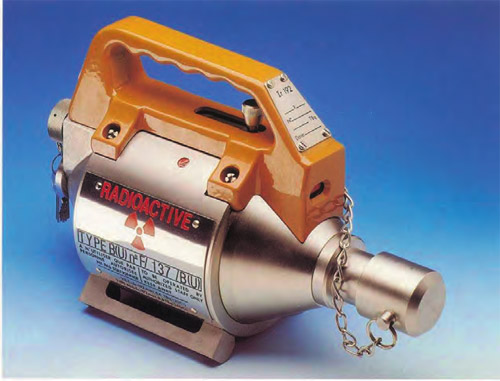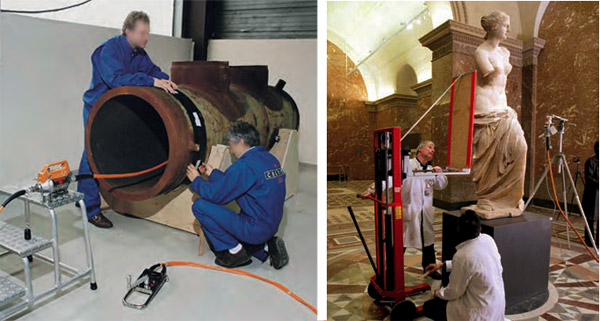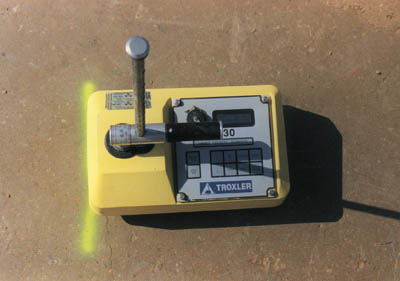A tool for testing and tune-ups

Gammagraphy device
A gammagraphy device is a mobile device that can be moved from one site to another. It consists mainly of: a radioactive source inserted in a source holder; a source projector, used to store the source when not in use and allowing its transport; an ejection jacket and a remote control system to move the source between the projector and the object to be radiographed, while ensuring the protection of the operator who stay away from the source.
© ASN
The penetrating property of radiations is commonly used to check welds in critical areas such as aircraft wings, engine housings or oil or gas pipelines. In most cases a gamma source is placed on one side of the material to be inspected and a detector (photographic film were in use for long) on the other. Possible flaws will be detected immediately.
Pipes and piping system corrosion is a recurring problem in the industry. By moving a gamma source along one side of a pipe and a detector on the other side, the level of corrosion can be determined precisely from the radiation attenuation. In some pipelines the use of radioactive tracers has helped to locate leaks.

Gammagraphy shots
On the left, technicians prepare a gammagraphy shot to inspect a heavy piece of ironwork. On the right, exposure to gamma rays rays of the Venus de Milo has revealed the weaknesses of its internal anatomy. The museum’s management decided to move it and take every precaution. Two technicians have installed the gammagraphy projector, which contains a source of cobalt-60 gamma rays with 1.17 and 1.33 MeV that will cross the marble to impress a radiographic film, revealing the metal tenons, memories of a repaired fracture that should be spared.
© Défis CEA
Gammagraphy is a nondestructive inspection technique, based on radioactive elements, which allows on a construction site, using a portable device, to assess inhomogeneities in the metal and especially in the string welding. This technique uses in particular sources of iridium 192 and cobalt 60, of which the activity does not exceed twenty TBq (Terabecquerels.)
On public works and agriculture, it is sometimes necessary to measure the soil density and moisture. One uses gammadensimetry, which operate with two radioactive sources: a gamma source of cesium 137 for soil density and a neutron source of americium-beryllium for measuring humidity.
Control of the wear of mechanical parts in engines is one of the first industrial applications of radioactivity. The surface of a critical mechanical component (such as a gearbox, a landing gear) is made slightly radioactive by irradiation. As a result of this surface wear during operation, a radioactive material is deposited into the lubricating oil flow. The oil is analyzed for metal loss and therefore the degree of wear of the workpiece during operation, without requiring disassembly and reassembly of the engine. This results in a saving in time and investment for the development of the apparatus.

Gammadensimeter
Gammadensimetry is a measurement technique of soil density and moisture, particularly in agriculture and public works. These devices operate with two sealed radioactive sources emitting gamma rays and neutrons. Gamma radiation from Caesium 137 (Cs 137) are used for measurements of density and neutron radiation emitted by the source Americium 241-Beryllium (Am 241 – Be) for measuring humidity.
©ASN
The characteristic X ray emission of atoms present in a sample of material triggered by the passage of radiation in matter allows to identify the presence of yhe atoms. This activation phenomenon is used to control precisely the layers of metallic coatings in the production of special steels such as galvanized steel.
Other applications include inspection of nuclear fuel assemblies, detection of flaws in gas turbine blades, quality control of ceramics.
Other articles on the subject « Applications of Radioactivity »
Material Developmnent
Improvements in the quality of industrial products Every day we make use of products that have be[...]
Non Destructive Testing
Control of industrial processes and materials Tracers and radioactive sources are frequently used[...]
Food processing
Eradicate bacteria, fungi and pests with radiation … Gamma rays are used industrially to en[...]
Food Preservation
Conservation and preservation of food The effects of radiation on the cells of living or vegetabl[...]
Conservation Effects
A conservation process without additives, non radioactive The biological effects of strong doses [...]
Medfly Eradication
The curse of the medfly and its eradication The Mediterranean flies or Medflies are a dreadful cu[...]
Disinfecting Effects
Getting rid of parasites and germs….. The radiobiological action of radiation leads to damage to [...]
Radioactive Gauges
Instruments for industrial process control In order to be peforming and efficient; modern industr[...]
Sources in Industry
A wide variety of applications Most radioelements in radioactive sources are extracted from small[...]
Various Applications
Because of the fears it inspires, radioactivity is considered in the collective unconscious as ho[...]